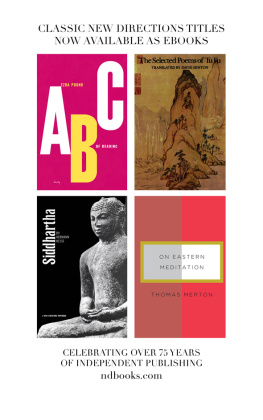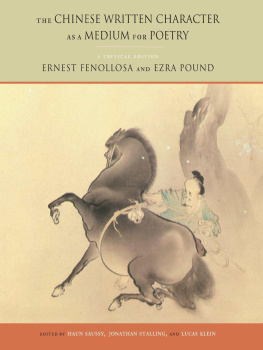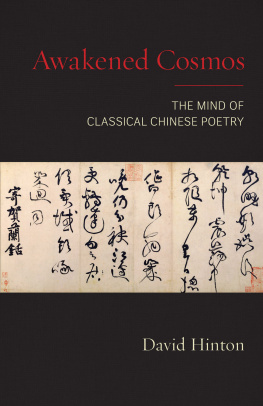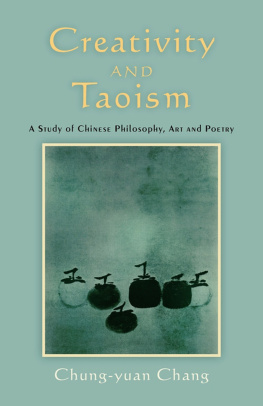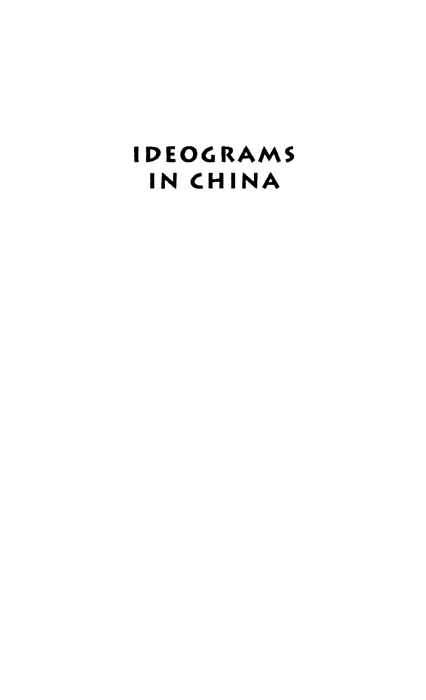
ALSO BY HENRI MICHAUX
available from New Directions:
A BARBARIAN IN ASIA
SELECTED WRITINGS

Ideograms in China
Copyright 1975 by Henri Michaux
Translation Copyright 1984 by Gustaf Sobin
Afterword Copyright 2002 by Richard Sieburth
Published by arrangement with Henri Michaux and Gustaf Sobin.
All rights reserved. Except for brief passages quoted in a newspaper, magazine, radio, or television review, no part of this book may be reproduced in any form or by any means, electronic or mechanical, including photocopying and recording, or by any information storage and retrieval system, without permission in writing from the Publisher.
The original French text of Idogrammes en Chine was published by Fata Morgana, Montpelier, France, in 1975.
This translation was originally published in the Fall 1984 anthology of New Directions in Prose & Poetry 48, and also as a limited edition by New Directions in 1984.
First published as a New Directions Paperbook (NDP929) in 2002.
Manufactured in the United States of America.
Published simultaneously in Canada by Penguin Books Canada Limited.
ISBN 978-0-8112-1490-2
eISBN 978-0-8112-2522-9
New Directions Books are published for James Laughlin
by New Directions Publishing Corporation
80 Eighth Avenue, New York 10011
To Kim Chi

What, as apparent scribble, was once compared to the tracks of insects or the erratic footprints of birds upon sand still conveys, unchanged, perfectly legible, comprehensible, and efficacious, the Chinese language, the oldest living language in the world.
Lines going off in all directions. In every which way: commas, loops, curlicues, stress marks, seemingly at every point, at all levels: a bewildering thicket of accents.
Cracks, claw marks: the very beginnings appear to have been suddenly checked: arrested.
Without form, figure, or body, without contour, symmetry, or center, without evoking any known property whatsoever.
Without any apparent rule of simplification, unification, generalization.
Neither stripped nor refined, lacking sobriety.
Each seems, at first sight, as if scattered.

Ideograms devoid of all evocation.
Characters of an unending variety.
The page, containing them, like a lacerated void.
Lacerated by a multitude of undefined lives.
There was a time, however, when the signs still spoke, or nearly; when, already allusive, they revealed rather than simple things or bodies or materials groups, ensembles, situations.
There was a time There were others, as well. Without making any attempt to simplify or condense, each period obfuscating for its own particular sake, setting things to rout, learned how to manipulate the characters, to separate them even furtherin some new wayfrom their original reading.

Interval.
What won out, finally, was the tendency to conceal. Reserve, prudence won out, a natural restraint, and that instinctive Chinese habit of covering ones tracks, of avoiding exposure.
What won out was the pleasure of remaining concealed. Thus the text, henceforth, covert, secret: a secret between initiates.
A long and involved secret, not readily shared, the requisite for belonging to that society within a society. That circle which, for centuries, would remain in power. That oligarchy of the subtle.
The pleasure of abstraction won out.
The brush freed the way, and paper made the going easier.
One could now readily abstract from the original reality, from the concrete and its closely related signs;
Diminished, deformed as they are, these characters, illegible to hundreds of millions of Chinese, never entirely lost their meaning. Excluded from the inner circle of the literate, the peasantry looked upon these characters without, admittedly, understanding them, but sensing nonetheless that they came from the same place as themselves: those nimble signs, predecessors to the incurvated rooftops, to dragons and theatrical figures, to cloud drawings and landscapes with flowering branches and bamboo leaves, all of which theyd seen in pictures and knew how to appreciate.
could abstract, move swiftly with abrupt brushstrokes that slid, unhesitating, across the paper, giving Chinese an entirely new appearance.
Withdrawal, self-absorption won out.
Won out: the will to be mandarin.
Gone, now, were those archaic characters that had stirred the heart. And those signs, so palpable, that had overwhelmed their own creators and amazed their very first readers.
Gone, too, were the veneration and simplicity, the earliest poetry, the tenderness that arose from the surprise of the first encounter. Gone, the still pious brushstroke and the gliding ease. (Still absent, yet to come, the intellectuals with their deft tracings: the tracings of intellectuals of scribes).
All contact cut, now, with the beginnings

Innovating, at first, with prudence, but with a growing disrespect and with the joy at seeing that it worked, that one was still being followed, understood
Carried away by the seductive effrontery of their own pursuits, the inventorsthose of the second periodlearned how to detach the sign from its model, deforming it cautiously, at first, not yet daring to sever form from being: the umbilical, that is, of resemblance. And, in so doing, detached themselves, rejected the sacred from that earliest equation: word-object.
Religion in writing was on the decline; the irreligion of writing had just begun.
Gone, now, were the heartfelt characters, so dependent upon reality. Vanished from usage, from language. They remained, however, upon the slabs of the oldest tombs, on the bronze vases dating from the earliest dynasties. Remained, too, upon divinatory bones.
Later, those early characters, sought after everywhere throughout the Middle Kingdom, meticulously compiled and recopied, were interpreted by scholars. An inventory, a dictionary of original signs, was established.
Rediscovered,
and rediscovering, at the same time, the emotion inherent in those calm, tender, tranquil first writings.
The characters, restored to their original meanings, came back to life.
In this perspective, any written page, any surface covered with characters turns into something crammed and seething full of lives and objects, of everything to be found in the world, in the world of China,
full of moons and hearts, full of doors
full of men who bow
who withdraw, grow angry, and make amends
full of obstacles
full of right hands, of left hands
of hands that clasp, that respond, that join forever
full of hands facing hands
of hands on guard, and others at work
full of mornings
full of doors
full of water falling, drop by drop, out of clouds
Next page
